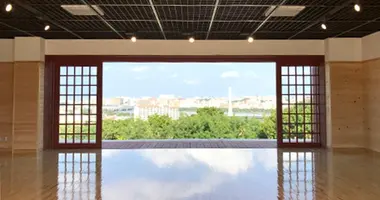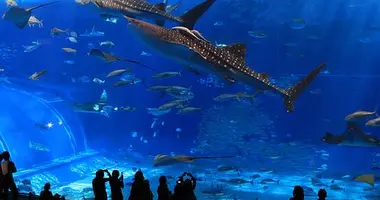Okinawa War Memorial Museums
- Published on : 02/08/2019
- by : Japan Experience
- Youtube
Okinawa War Memorials 沖縄
- Peace Memorial Museum
- Former Japanese Navy Underground Headquarters
- Himeyuri Peace Museum
- Tsushima Maru Memorial Museum
- Japan Museums

Okinawa Peace Hall, Okinawa
Okinawa was the site of one of the bloodiest battles of the Pacific War. Almost as many people died here as in the two atom bomb attacks on Hiroshima and Nagasaki.
The details of the Battle of Okinawa make for grim reading. Total deaths were 200,656, the majority of them Okinawan civilians. 2,716,691 shells were fired by the US military, an incredible 4.72 shells per person on Okinawa.
The campaign was known to the Japanese defenders of the island as the "Typhoon of Steel."
There are several war memorials on Okinawa main island and museums related to the tragic conflict.
Here is a listing of war memorials on Okinawa.

Peace Memorial Park, Mabuni Hill, Okinawa

Peace Memorial Park, Okinawa
Okinawa Prefectural Peace Memorial Museum 沖縄県立平和祈念資料館
The Peace Memorial Museum, south of Naha, is the main memorial to the Battle of Okinawa which took place during World War II on Okinawa's main island.
The Okinawa Prefectural Peace Memorial Museum's aims are to promote peace through the study and research of the deadly events that took place here and which saw the deaths of over 200,000 people both civilian and military in the latter days of the Pacific War in 1945.
The Okinawa Prefectural Peace Memorial Museum is located on a very large site on Mabuni Hill where the Battle of Okinawa came to a bitter end and where the most bloodshed ensued.

Former Japanese Navy Underground Headquarters, Naha, Okinawa

Photograph of Okinawan children after the end of hostilities on display at the Former Japanese Navy Underground Headquarters
Former Japanese Navy Underground Headquarters 旧海軍司令部壕
The Former Japanese Navy Underground Headquarters in Naha bear graphic witness to the deadly battle for Okinawa in 1945.
It was here that Rear Admiral Minoru Ota and 4,000 of his men were killed in combat with the US 6th Marine Division.
Many Japanese sailors, thought to be around 175 men, including Ota, committed suicide, some using hand grenades. Ota shot himself with his pistol. Indeed, it is still possible to see the marks in the plaster walls made by the exploding grenades used by the men to kill themselves.
Many of the men, who did not take their own lives, attacked the US marines outside using makeshift weapons in a desperate last charge and were decimated.
2,400 bodies were found in and around the headquarters when the fighting ended.
To get to the Former Japanese Navy Underground Headquarters take Okinawa bus #33, #46 or #101 from Naha bus station. Get off at Tomigusuku Castle Park, from where it is a 10 minute walk.

Memorial with the names of the children and their teachers killed at the site, Himeyuri Peace Museum, Okinawa
Himeyuri Peace Museum ひめゆり学徒隊
The Himeyuri Peace Museum commemorates 210 high school girls and their teachers who were killed by American fire during the conflict.
The girls were from Okinawa First Girls' High School and Okinawa Women's Normal School and had been inducted in to the Okinawa Army Field Hospital in the village of Haebaru, about 3 miles south east of Naha. The name Himeyuri comes from the nickname for Okinawa Women's Normal School.
The site includes the cave and the Himeyuri Peace Museum with photographs, videos, survivors’ accounts and other exhibits explaining the lives and sacrifice of the school girls. The girls met their fate not just in the cave but also outside from American fire. Others committed suicide with grenades or shells.
The miserable conditions of the inter-connected caves that served as a hospital are recreated with dioramas. The museum has a very strong anti-war message. A visit here is a moving experience.
To get to the Himeyuri Peace Museum take bus #82, #107 or #108 from Itoman. The Himeyuri Peace Museum is on Highway 331.

The design of the Tsushima Maru Memorial Museum reflects that of a ship
Tsushima Maru Memorial Museum 対馬丸記念館
The moving Tsushima Maru Memorial Museum in Naha, is dedicated to the victims (mostly children) of the sinking of the Tsushima Maru ship in 1944 during World War II.
The doomed vessel was evacuating children from Okinawa to Kagoshima on the mainland when it was sunk by a torpedo fired by the submarine USS Bowfin.
In all of the 1,788 people on board, 80% were drowned. The affair was hushed up by the Japanese authorities. The crew of the Bowfin only heard that their prey had been carrying children 20 years after the war had ended.
The Tsushima Maru Memorial Museum tells the story of this war-time tragedy through photographs, wall panels, as well as belongings of the victims. A classroom, where some of the children who died had studied, has been recreated.
Behind the museum close to Gokokuji Temple in Memorial Park is the Kozakura Monument - a memorial cenotaph raised by public donations of 1 yen in the 1950’s by people in Aichi Prefecture. The somber memorial done in black and white stone is a fitting place to ponder the horrors of war, especially when it affects innocent young children.
The stone memorial with the names of the victims engraved on it mirrors the shape of the prow of the Tsushima Maru.
To get to the museum, get off the Yui Monorail at Kenchomae Station and walk about 15 minutes. Alternatively take a Naha City Bus, any of numbers 1, 2, 3, 5, 15, 45 and get off at Nishinjo or Kume Yubinkyokumae and walk five minutes.
Other Places
At Cape Kyan at the southern tip of the island many Japanese soldiers and civilians committed suicide by jumping off the cliff.
The Tomari International Cemetery at Tomari Port in Naha contains the graves of (mostly American) foreigners who died in Okinawa, other than those killed in the Battle of Okinawa in 1945.
Hotels in Okinawa
Some recommended places to stay in Naha are: the Hotel Royal Orion, Okinawa Washington Hotel, the Okinawa Hotel and Pacific Hotel Okinawa.

Peace Memorial Park, Okinawa

Eternal Flame, Peace Memorial Park, Mabuni Hill
Books on Japan & Okinawa
Okinawa War Memorial Museums: see a listing of museums and places of interest dedicated to the deadly 1945 Battle of Okinawa.














